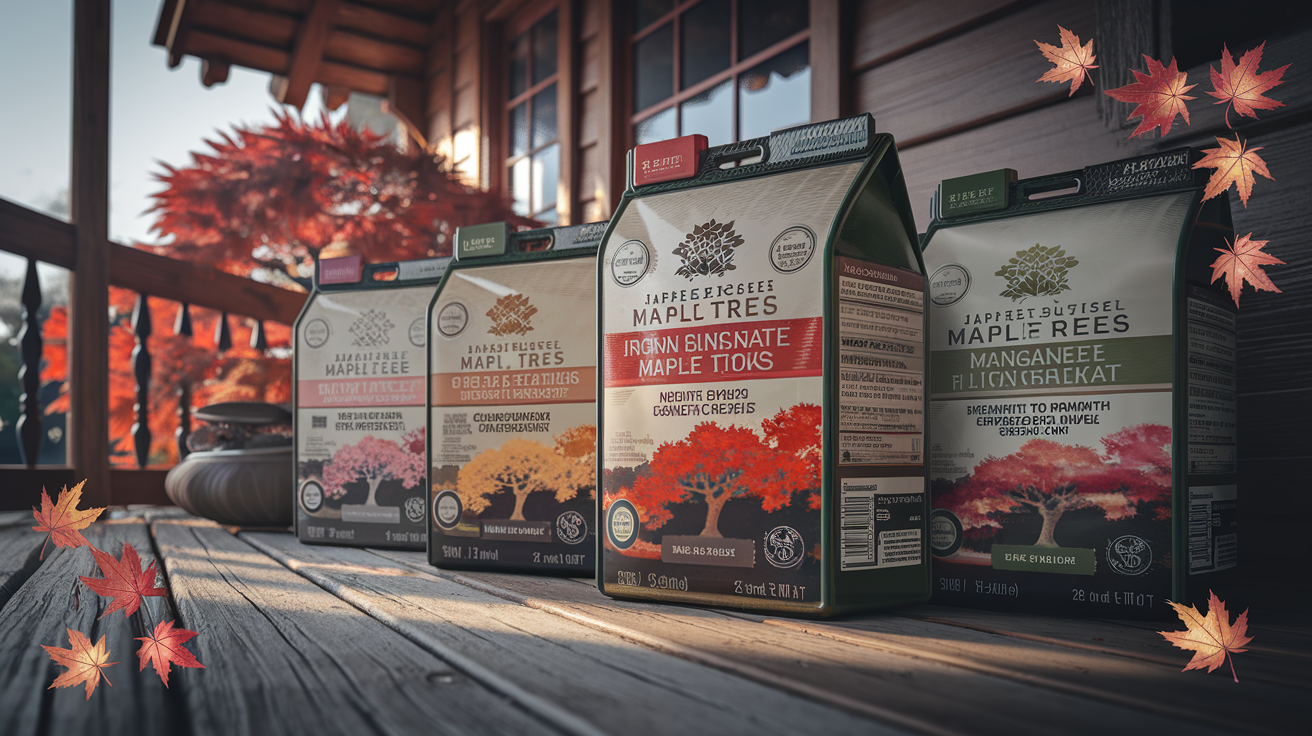Welcome to Rhys Garden, your trusted companion in the art of cultivating Japanese maples. As any seasoned gardener knows, these elegant trees are the crown jewels of many landscapes, their delicate leaves and graceful form adding a touch of Oriental charm to gardens around the world. But to truly thrive, these botanical treasures require the right nutrients.
Let’s delve into the world of fertilizers for Japanese maples, exploring how to give these living sculptures the nourishment they need to flourish.
Understanding Japanese Maples and Their Nutritional Needs
Japanese maples (Acer palmatum) are renowned for their stunning foliage and architectural beauty. These ornamental trees have graced gardens for centuries, captivating plant enthusiasts with their diverse leaf shapes, colors, and growth habits. To maintain their vigor and vibrant hues, it’s crucial to understand their unique nutritional requirements.
The Soil: The Foundation of Japanese Maple Health

Before we discuss fertilizers, it’s essential to address the soil, which is the very foundation of your Japanese maple’s health. These trees prefer well-draining, slightly acidic soil with a pH between 5.5 and 6.5. Conducting a soil test is an excellent first step in determining your tree’s nutritional needs.
Macronutrients vs. Micronutrients
Like all plants, Japanese maples require both macronutrients and micronutrients:
- Macronutrients: Nitrogen (N), Phosphorus (P), and Potassium (K)
- Micronutrients: Iron, Manganese, Zinc, Copper, Boron, and Molybdenum
Understanding the role of each nutrient is key to selecting the right fertilizer for your Japanese maple.
Choosing the Right Fertilizer for Japanese Maples
When it comes to fertilizing Japanese maples, a gentle approach is best. These trees are not heavy feeders and can be sensitive to over-fertilization. Let’s explore the options available and how to choose the best one for your tree.
Organic vs. Synthetic Fertilizers
Both organic and synthetic fertilizers can be effective for Japanese maples, but each has its pros and cons:
Organic Fertilizers
Organic fertilizers, derived from natural sources, offer several benefits:
- Slow-release nutrients that feed the tree gradually
- Improvement of soil structure and microbial activity
- Lower risk of fertilizer burn
Examples of organic fertilizers suitable for Japanese maples include:
- Composted manure
- Fish emulsion
- Bone meal
- Seaweed extracts
Synthetic Fertilizers
Synthetic fertilizers, while more concentrated, can be used effectively if applied correctly:
- Provide precise nutrient ratios
- Often more cost-effective
- Can address specific nutrient deficiencies quickly
When using synthetic fertilizers, opt for slow-release formulations to minimize the risk of overfertilization.
NPK Ratios for Japanese Maples
The ideal NPK ratio for Japanese maples is typically lower in nitrogen compared to many other plants. A balanced fertilizer with an NPK ratio of 5-5-5 or 4-4-4 is often recommended. For mature trees, a ratio slightly higher in phosphorus and potassium, such as 3-5-5, can promote better root development and overall health.
Application Methods and Timing
Proper application of fertilizer is just as important as choosing the right type. Let’s discuss when and how to fertilize your Japanese maple for optimal results.
When to Fertilize
The best time to fertilize Japanese maples is in early spring, just before new growth begins. This timing allows the tree to access nutrients as it enters its active growing phase. Some gardeners also apply a light fertilizer in early summer, but avoid fertilizing in late summer or fall, as this can stimulate new growth that may be damaged by winter frosts.
How to Apply Fertilizer
There are several methods to apply fertilizer to Japanese maples:
- Granular Application: Spread granular fertilizer evenly around the drip line of the tree, avoiding direct contact with the trunk.
- Liquid Feeding: Dilute liquid fertilizers according to package instructions and apply to the soil around the tree’s root zone.
- Deep Root Feeding: For established trees, consider using a deep root feeder to deliver nutrients directly to the root system.
- Foliar Feeding: Some micronutrients can be applied as a foliar spray, but use this method sparingly and follow product instructions carefully.
Dosage and Frequency
As a general rule, apply fertilizer at half the recommended rate for Japanese maples. It’s better to under-fertilize than to risk damaging the tree with excess nutrients. For most Japanese maples, fertilizing once or twice a year is sufficient.
Special Considerations for Container-Grown Japanese Maples
Japanese maples grown in containers have different fertilizer needs compared to those planted in the ground. Container plants typically require more frequent feeding due to the limited soil volume and nutrients being washed out during watering.
Container Fertilizer Tips
- Use a slow-release fertilizer formulated for acid-loving plants
- Apply fertilizer more frequently, but at a lower concentration
- Consider supplementing with liquid fertilizer during the growing season
- Ensure proper drainage to prevent salt buildup from fertilizers
Signs of Nutrient Deficiencies and Overfertilization
Knowing how to read your Japanese maple’s health signs is crucial for proper fertilization. Here are some indicators to watch for:
Nutrient Deficiency Symptoms
- Yellowing leaves (chlorosis) – often indicates nitrogen or iron deficiency
- Purple or reddish leaves (when they should be green) – may signal phosphorus deficiency
- Browning leaf edges – could be a sign of potassium deficiency
Overfertilization Symptoms
- Leaf burn or scorching
- Rapid, weak growth
- Wilting or dropped leaves
- Salt crust on soil surface
If you notice any of these symptoms, adjust your fertilization routine accordingly and consult with a local horticulturist if problems persist.
Organic Alternatives and Soil Amendments
For those preferring a more natural approach, there are several organic alternatives and soil amendments that can benefit Japanese maples:
Compost and Mulch
Applying a layer of well-rotted compost or organic mulch around your Japanese maple can:
- Slowly release nutrients into the soil
- Improve soil structure and water retention
- Regulate soil temperature
- Suppress weed growth
Mycorrhizal Fungi
Introducing mycorrhizal fungi to the soil can enhance your Japanese maple’s ability to absorb nutrients and water. These beneficial fungi form a symbiotic relationship with the tree’s roots, effectively extending the root system.
Natural Soil Acidifiers
To maintain the slightly acidic soil that Japanese maples prefer, consider using natural soil acidifiers such as:
- Pine needles
- Coffee grounds
- Elemental sulfur (use sparingly and test soil pH regularly)
Fertilizer Recipes for Japanese Maples
For the DIY enthusiasts, here are some homemade fertilizer recipes that can be effective for Japanese maples:
Balanced Organic Fertilizer Mix
- 4 parts seed meal or alfalfa meal
- 1 part bone meal
- 1 part kelp meal
- 1 part dolomite lime
Mix these ingredients thoroughly and apply lightly around the drip line of your Japanese maple in early spring.
Liquid Compost Tea
- Fill a burlap sack with finished compost
- Submerge the sack in a bucket of water
- Let it steep for 24-48 hours
- Dilute the resulting “tea” 1:10 with water before applying to your Japanese maple
This nutrient-rich solution can be applied monthly during the growing season.
Common Questions About Fertilizing Japanese Maples
Let’s address some frequently asked questions about fertilizing Japanese maples:
Q: Can I use a general-purpose fertilizer on my Japanese maple?
A: While general-purpose fertilizers can be used, it’s best to choose a fertilizer specifically formulated for acid-loving trees or use a balanced, slow-release fertilizer with a low NPK ratio.
Q: How often should I fertilize my Japanese maple?
A: For most Japanese maples, fertilizing once in early spring is sufficient. Container-grown trees may benefit from a second light application in early summer.
Q: Is it necessary to fertilize established Japanese maples?
A: Established Japanese maples in nutrient-rich soil may not need regular fertilization. Always observe your tree’s health and growth before deciding to fertilize.
Q: Can fertilizer change the color of my Japanese maple’s leaves?
A: While fertilizer itself doesn’t directly change leaf color, proper nutrition can enhance the natural color of your Japanese maple. Overfertilization, particularly with nitrogen, can lead to excessive green growth at the expense of red or purple pigmentation.
Q: How can I make my Japanese maple grow faster?
A: Japanese maples are naturally slow-growing trees. While proper fertilization can support healthy growth, it’s best not to try to force rapid growth, as this can lead to weak structure and reduced ornamental value.
Expert Tips for Fertilizing Japanese Maples
To round out our comprehensive guide, here are some expert tips to keep in mind when fertilizing your Japanese maple:
- Less is More: Japanese maples are sensitive to overfertilization. When in doubt, use less fertilizer than you think you need.
- Water Before and After: Always water your Japanese maple thoroughly before and after applying fertilizer to prevent root burn and help distribute nutrients.
- Monitor pH: Regularly check your soil’s pH and adjust as necessary to maintain the slightly acidic conditions that Japanese maples prefer.
- Customize Your Approach: Every Japanese maple and garden environment is unique. Observe your tree’s response to fertilization and adjust your practices accordingly.
- Combine Nutrition with Proper Care: Remember that fertilization is just one aspect of Japanese maple care. Proper watering, pruning, and protection from extreme weather are equally important for your tree’s health.
Conclusion
Fertilizing Japanese maples is both an art and a science. By understanding your tree’s nutritional needs and applying the right fertilizer at the right time, you can help your Japanese maple thrive and become a centerpiece of your garden for years to come. Remember, these graceful trees are not just plants; they’re living sculptures that can be passed down through generations with proper care.
At Rhys Garden, we believe that every Japanese maple has the potential to be a masterpiece. By following the guidelines and tips in this comprehensive guide, you’re well on your way to nurturing a healthy, vibrant Japanese maple that will be the envy of your neighborhood. Happy gardening, and may your Japanese maple flourish under your attentive care!

Related Posts
The Ultimate Guide to Fertilizing For Maple Trees
Unlock the Power of Organic Spent Mushroom Compost
What Fertilizer Is Highest In Nitrogen? Boosting Your Garden’s Green Growth